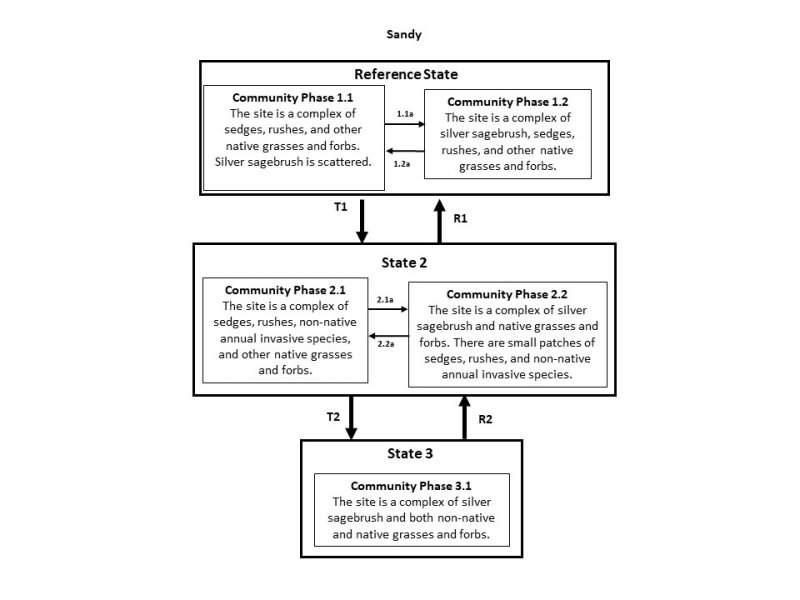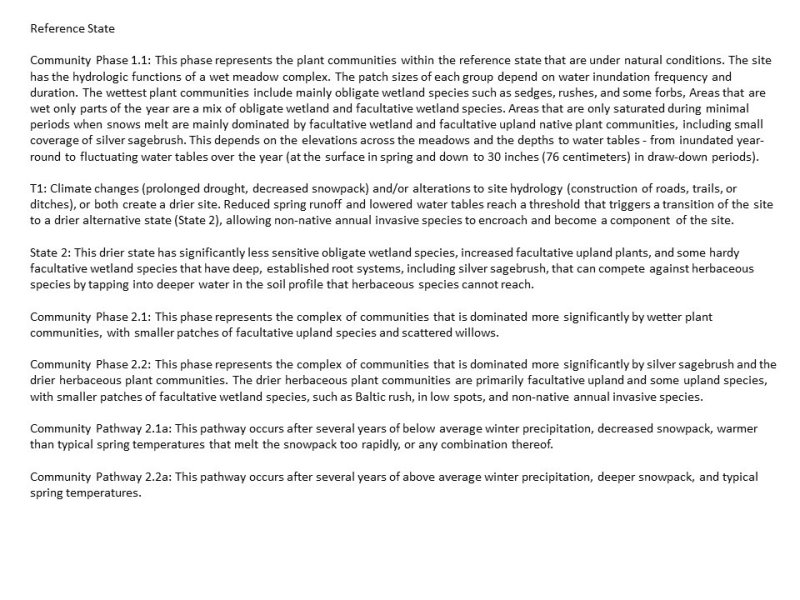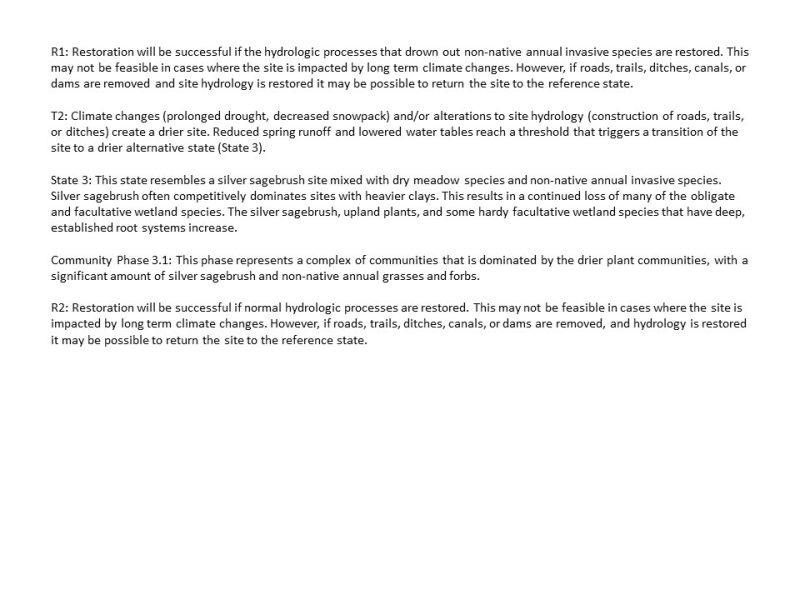Ecological site group R021XG911CA
Sandy
Last updated: 08/26/2024
Accessed: 12/21/2025
Ecological site group description
Key Characteristics
- Upland sites
- 12-30" ppt
- > 20" depth
- Sandy texture
Provisional. A provisional ecological site description has undergone quality control and quality assurance review. It contains a working state and transition model and enough information to identify the ecological site.
Physiography
This ESG is on flood plains and low stream terraces. Slopes are generally 0 to 2 percent.
Climate
The climate is semiarid with cool, moist winters and warm, dry summers. The mean annual precipitation is 12 to 18 inches (305 to 460 millimeters), much of which falls as snow. The mean annual temperature is 44 to 49 degrees F (7 to 9 degrees C). The mean January temperature is about 30 degrees F (-1 degrees C). The mean July temperature is about 69 degrees F (21 degrees C). The frost-free period is 60 to 90 days.
Soil features
The soils for this ESG are very deep, somewhat poorly drained, and formed in alluvium derived from mixed rocks. They generally have very low or low surface runoff and moderate permeability. Endosaturation is present with an apparent seasonally high water table that comes within 3 feet (1 meter) of the soil surface (moderately deep free water occurrence class) between March and May. Cumulative annual duration class is transitory. These soils are susceptible to rare flooding for very brief periods year-round or occasional flooding for brief periods between January and May.
The Beckwourth series (coarse-loamy, mixed, superactive, mesic Oxyaquic Argixerolls) is representative of this ESG.
Vegetation dynamics
There are few descriptions of Bolander silver sagebrush (Artemisia cana ssp. bolanderi) communities in the literature. Bolander silver sagebrush types on the Toiyabe National Forest of west-central Nevada and east-central California are co-dominated by Douglas' sedge (Carex douglasii), Baltic rush (Juncus balticus), or both. Descriptions of Bolander silver sagebrush communities in California are particularly sparse, although a community co-dominated by mat muhly (Muhlenbergia richardsonis) has been documented in Lassen County. In nearby Plumas County, Bolander silver sagebrush grows in association with mountain big sagebrush (Artemisia tridentata), Nebraska sedge (Carex nebrascensis), and tufted hairgrass (Deschampsia cespitosa). This ecological site group encompasses the range for both silver sagebrush (Artemisia cana) and Bolander silver sagebrush (Artemisia cana ssp. bolanderi); in this description’s narrative, the Bolander subvariant will be lumped in with silver sagebrush (Artemisia cana).
Silver sagebrush requires more moisture than most sagebrush species. It grows on areas that receive at least 10 inches (250 millimeters) of mean annual precipitation and have a water table within 3 feet (1 meter) of the soil surface. For example, a silver sagebrush/Sandberg bluegrass community in Plumas County, California is on streamside soils with a mean July moisture content of 36 percent and a mean water table depth of 47.6 inches (121 centimeters). Because it requires moist soils, silver sagebrush typically grows on floodplains, moist meadows, and the edges of streambanks and drainages.
Silver sagebrush grows on moister, colder soils than any other woody sagebrush species in North America. Soil drainage is often slow. Silver sagebrush communities are also common on transitional wet-to-dryland sites where soils dry by late summer. A mountain silver sagebrush/tufted hairgrass community in Yellowstone National Park is described as "the driest wetland community type" within the park. Phosphorus, potassium, nitrogen, organic matter, and cation exchange capacity are often lower in silver sagebrush soils than in soils of surrounding communities. Silver sagebrush cannot tolerate strongly saline or calcareous soils. Parent materials of soils supporting silver sagebrush include sandstones, shales, and granites. Soil textures include clay, silt, loam, sand, and gravel.
Silver sagebrush is most common on pluvial lakebeds, internally drained basins with alkaline soils, and snow catchments with granitic soils. It also grows on meadows, streambanks, and moist, gravelly soils. It is the only sagebrush in North America that can tolerate
temporary inundation. Silver sagebrush grows at 4,400 to 11,000 feet (1,300 to 3,400 meters) elevation. Silver sagebrush has superior flooding tolerance compared to other woody sagebrush species. Drought tolerance of silver sagebrush is uncertain. The species is markedly sensitive to water stress in the seedling stage and is noted as either drought-intolerant or tolerant at maturity. Within the species, Bolander silver sagebrush is ranked most drought-tolerant.
Major Land Resource Area
MLRA 021X
Klamath and Shasta Valleys and Basins
Stage
Provisional
Click on box and path labels to scroll to the respective text.


